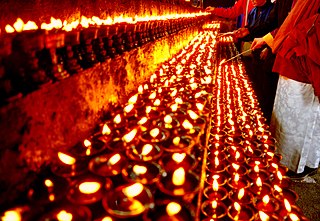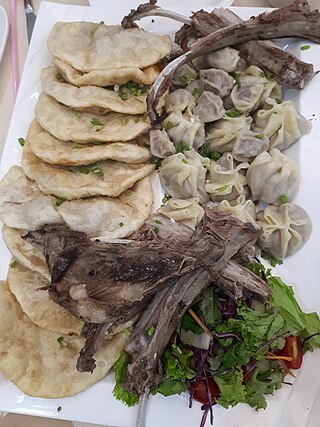
Momos are a type of steamed filled dumpling in Tibetan and Nepali cuisine that is also popular in neighbouring Bhutan, Bangladesh, and India. The majority of Tibetan momos are half-moon in shape like jiaozi, while Nepali momos are normally round like baozi. Momos are usually served with a sauce known as achar influenced by the spices and herbs used within many South Asian cuisines. It can also be used in soup, as in jhol momo and mokthuk.

Losar also known as Tibetan New Year, is a festival in Tibetan Buddhism. The holiday is celebrated on various dates depending on location tradition. The holiday is a new year's festival, celebrated on the first day of the lunisolar Tibetan calendar, which corresponds to a date in February or March in the Gregorian calendar. In 2024, the new year commenced on 10 February and celebrations ran until the 12th of the same month. It also commenced the Year of the Male Wood Dragon.

Tibet developed a distinct culture due to its geographic and climatic conditions. While influenced by neighboring cultures from China, India, and Nepal, the Himalayan region's remoteness and inaccessibility have preserved distinct local influences, and stimulated the development of its distinct culture.

Noodle soup refers to a variety of soups with noodles and other ingredients served in a light broth. Noodle soup is a common dish across East Asia, Southeast Asia and the Himalayan states of South Asia. Various types of noodles are used, such as rice noodles, wheat noodles and egg noodles.

Thenthuk or hand-pulled noodle soup (thukpa), is a very common noodle soup in Tibetan cuisine, especially in Amdo, Tibet where it is served as dinner and sometimes lunch. The main ingredients are wheat flour dough, mixed vegetables and some pieces of mutton or yak meat. Vegetable thenthuk is a common modern-day option too.

Chotrul Düchen, also known as Chonga Choepa or the Butter Lamp Festival, is one of the four Buddhist festivals commemorating four events in the life of the Buddha, according to Tibetan traditions. Chotrul Düchen closely follows Losar, the Tibetan New Year. It takes place on the fifteenth day of the first month in the Tibetan calendar during the full moon. The first fifteen days of the year celebrate the fifteen days during which the Buddha displayed miracles for his disciples so as to increase their devotion. During Chötrul Düchen, it is believed that the effects of both positive and negative actions are multiplied ten million times.

Thukpa is a Tibetan noodle soup, which originated in the eastern part of Tibet. Amdo thukpa, especially thenthuk, is a variant among the Indians, especially Ladakhis and the Sikkimese. Thukpa can be prepared in both vegetarian and non-vegetarian variations; the most popular non-vegetarian variation includes chicken.

Tibetan cuisine includes the culinary traditions and practices of the Tibetan people in the Tibet region. The cuisine reflects the Tibetan landscape of mountains and plateaus and includes influences from neighbors. It is known for its use of noodles, goat, yak, mutton, dumplings, cheese, butter, yogurt, and soups. Vegetarianism has been debated by religious practitioners since the 11th century but is not prevalent due to the difficulty of growing vegetables, and cultural traditions promoting consumption of meat.

Mongolian cuisine predominantly consists of dairy products, meat, and animal fats. The most common rural dish is cooked mutton. In the city, steamed dumplings filled with meat—"buuz"— are popular.

Nepali cuisine comprises a variety of cuisines based upon ethnicity, alluvial soil and climate relating to cultural diversity and geography of Nepal and neighboring regions of Sikkim and Gorkhaland. Dal-bhat-tarkari is eaten throughout Nepal. Dal is a soup made of lentils and spices, bhat — usually rice but sometimes another grain — and a vegetable curry, tarkari. Condiments are usually small amounts of spicy pickle which can be fresh or fermented, mainly of dried mustard greens and radish and of which there are many varieties. Other accompaniments may be sliced lemon (nibuwa) or lime (kagati) with fresh green chilli and a fried papad and also Islamic food items like rice pudding, sewai, biryani etc. Dhindo (ढिंडो) is a traditional food of Nepal. A typical example of Nepali cuisine is the Chaurasi Byanjan set where bhat (rice) is served in a giant leaf platter (patravali) along with 84 different Nepali dishes each served on small plates. It is mostly fed during weddings and Pasni.

A staple of Bhutanese cuisine is Bhutanese red rice, which is like brown rice in texture, but has a nutty taste. It is the only variety of rice that grows at high altitudes. Other staples include buckwheat and increasingly maize.

Soup is a primarily liquid food, generally served warm or hot, that is made by combining ingredients of meat or vegetables with stock, milk, or water. Hot soups are additionally characterized by boiling or simmering solid ingredients in liquids in a pot until the flavors are extracted, forming a broth. Soups are similar to stews, and in some cases there may not be a clear distinction between the two; however, soups generally have more liquid (broth) than stews.

Mordovian cuisine is the traditional cuisine of the Mordovians, who now live in Mordovia and surrounding areas. It consists of a variety of dishes, based on geographical, cultural and climate features of the region, with fish traditionally featured heavily.

Guthuk is a stew soup in Sherpa or Tibetan cuisine, made with various ingredients like beans, vegetables, meat, or left over harvested grains. It is eaten two days before Losar, the Bot or Tibetan New Year and is a variation on thukpa bhatuk. The Tibetan religious ceremony Gutor (དགུ་གཏོར), literally meaning 'offering of the 29th', is held on the 29th of the 12th Bot or Tibetan month, and is focused on driving out all negativity, including evil spirits and misfortunes of the past year, and starting the new year in a peaceful and auspicious way. It is made with barley and other ingredients.
Nyi Shu Gu is the eve before the last day of the Tibetan year (29th). It is celebrated with various traditions leading up to the Tibetan New Year: Losar. Guthuk is a common Tibetan cuisine noodle soup that is associated with Nyi Shu Gu. Thukpa bhatuk is the common style of noodle soup that becomes Guthuk when eaten with special ingredients and elements on Nyi Shu Gu. Nyi Shu Gu is a time to cleanse and bid adieu to negativities, obstacles, uncleanliness and sickness. A fire is traditional as is washing up.

Galdan Namchot is a festival celebrated in Tibet, Nepal, Mongolia and many regions of Himalaya, particularly in Ladakh, India. It is to commemorate the birth as well as parinirvana (death) and the Buddhahood of Je Tsongkhapa, a famous Scholar/teacher of Tibetan Buddhism whose activities led to the formation of the Gelug school of Tibetan Buddhism. Galdan Namchot also marks the beginning of the new year celebrations in Ladakh.

Gyalpo Losar is a new year festival of Sherpa people of Nepal, Sikkim and Darjeeling. The festival is celebrated every year from Falgun Shukla Pratipada, the second day of the waxing moon until the full moon.

The culture of Ladakh refers to the traditional customs, belief systems, and political systems that are followed by Ladakhi people in India. The languages, religions, dance, music, architecture, food, and customs of the Ladakh region are similar to neighboring Tibet. Ladakhi is the traditional language of Ladakh. The popular dances in Ladakh include the khatok chenmo, cham, etc. The people of Ladakh also celebrate several festivals throughout the year, some of the most famous are Hemis Tsechu and Losar.
















